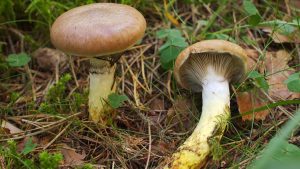#117: Craterellus cornucopioides species group, the Horn of Plenty
If Black Friday needed to be symbolized by a mushroom, I would suggest the Craterellus cornucopioides species group. Their common and scientific names bring to mind Thanksgiving, they are black in color, they are prized edibles but are rather difficult to find, and they are very thin-fleshed, so you need to find a lot of them to make a good meal. I love these little mushrooms. Their flavor is mild but unique, making them a great compliment to various dishes. These mushrooms go by a variety of common names: “Black Trumpets,” “Black Chanterelles,” “Horn of Plenty,” and “la trompette de la mort” (literally “Trumpet of Death”) in French. The French name must be based on the mushroom’s dark color, since I am not aware of anyone having died after consuming the Horn of plenty. I usually just call them “Black Chanterelles,” but I will use the name “Horn of Plenty”...







![#011: Characteristics of Kingdom Fungi [Archived]](https://www.fungusfactfriday.com/wp-content/themes/hueman/assets/front/img/thumb-small-empty.png)

